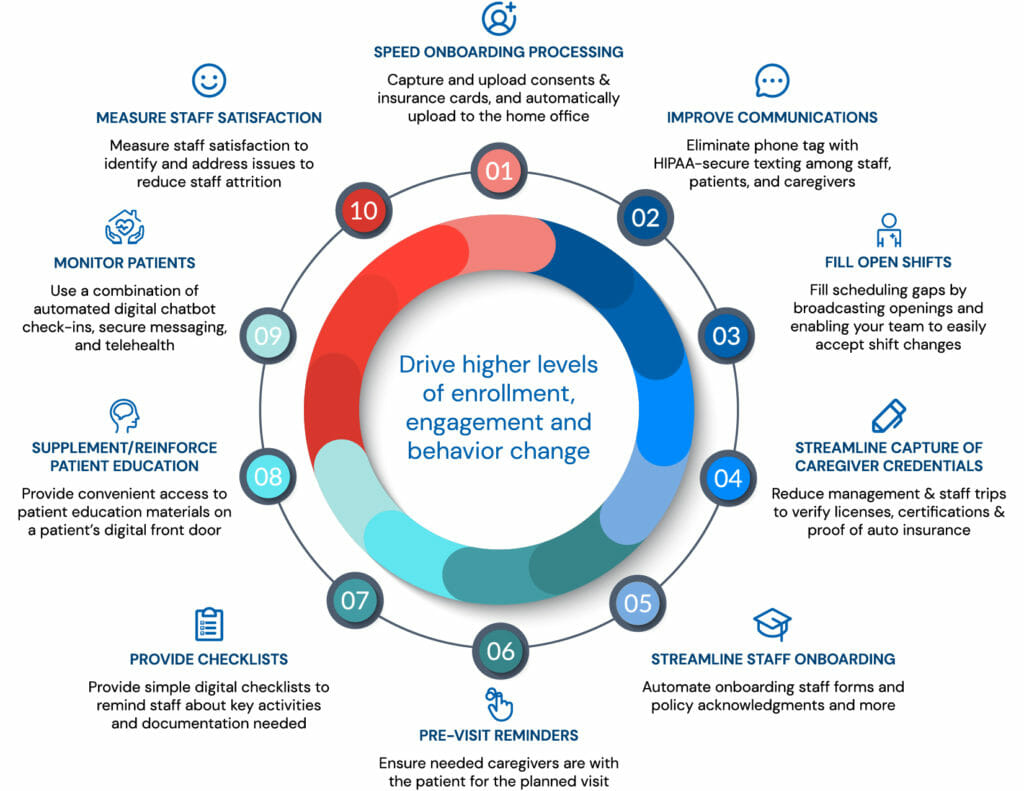Higher labor, benefit and administrative costs in the wake of the pandemic are continuing, squeezing already thin operating margins. A labor cost survey1 of the Partnership for Quality Home Health members conducted in August 2021 concluded that wages and home health industry expenses have increased dramatically since 2019, a trend that continues to worsen as inflation hits its highest point in decades.2
Though the pandemic greatly expanded telehealth reimbursement including hospital-at-home programs that employ remote monitoring, the Biden administration has finalized a 0.7% increase for home health in 2023, which includes a 3.925% permanent adjustment related to Patient-Driven Groupings Model.3 Likewise, starting Jan. 1, 2023, home health agencies’ performance will be subject to the expanded Home Health Value-based Purchasing (HHVBP) Model, and payment adjustments will begin in 2025 based on 2023 performance.4
Home healthcare agency administrators must address these issues to bend the administrative and labor cost curves and preserve margins. Artificial intelligence-enabled solutions can mitigate these challenges and meet the demand for aging in place. Consider the proven benefits of digital tools rapidly adopted by medical practices, hospitals and health systems:
- Reduced manual and routine administrative efforts burdening care teams and managers
- Increased staff retention by improving the employee-provider experience
- Proactive engagement of patients and caregivers to increase CAHPS performance
- Management of more patients using the same workers and without hiring additional staff
Digital options to automate home health administration
Empower your older patients and healthcare workers with digital-first strategies. Not only do chatbots, secure texting and virtual visits automate routine operational tasks, these digital tools yield big benefits that re-energize your leadership and staff to spend more time with patients.
Here’s a look at new and innovative home care use cases for AI:

- Improve communication and care coordination by replacing phone tag with HIPAA-secure texting among staff, patients and caregivers.
- Automate the filling of scheduling gaps by broadcasting openings and enabling your team to easily accept shift changes.
- Automate verifications to help reduce management and staff effort associated with verifying licenses, certifications, proof of auto insurance, and more.
- HHVBP offers opportunity: https://innovation.cms.gov/innovation-models/expanded-home-health-value-based-purchasing-model
- Streamline employee onboarding by automating transport of onboarding and assessment forms, education and consents.
- Speed patient onboarding to help enable staff to document consents, insurance, emergency contacts, referrals and other requirements, while concurrently uploading the documentation to the home office. During COVID-19, Walla Walla Community Hospice in Washington implemented digital intake in less than 14 days and reduced new patient in-home intake time by 30%.
- Supplement in-person visits by initiating a virtual visit to consult with peers or receive support for a specific patient need. Conduct routine check-ins remotely to reduce driving time and costs.
- Generate checklists to remind staff about key activities and documentation for inclusion in the visit.
- Send reminders to improve patient and caregiver satisfaction and engagement. For example, reduce no-shows by sending reminders of upcoming appointments to patients.
- Auto-measure staff satisfaction regularly to identify and address issues to reduce staff attrition.
Engage digitally with patients and caregivers
Senior adoption of digital technologies has grown markedly, according to the Pew Research Center.
Cell phone ownership is nearly ubiquitous among Americans, with 97% ownership. While ownership lags as the population ages, 83% of those ages 50-64 have a smartphone, as does 61% of those 65 and older,5 most family caregivers have smartphones.
Chatbots, which leverage conversational AI and national language processing, can be used instead for seamless interactions to increase CAHPS scores and staff satisfaction:
- Track patient and caregiver satisfaction
- Expedite patient onboarding with self-service options
- Educate patients and caregivers on their conditions, as needed
- Monitor patients remotely with a combination of automated digital chatbot check-ins, secure messaging, and telehealth
- Communicate with caregivers, replacing voice messages with text, phone, or virtual visits
- Help staff and caregivers avoid unscheduled home visits and/or hospitalizations
- Help patients and their caregivers improve their home health experience welcoming visiting healthcare professionals by issuing reminders with photos identifying the nurse, social worker or home health aide.
Make the digital transformation
Aging in place relieves the financial pressure of institutionalized care. Not only does remaining in the home significantly reduce administration cost and staff burden, but it also presents an affordable opportunity to better serve this population with high-quality care.
Armed with chatbots and other virtual care services, home healthcare agencies, with support from payers and the government, can build and strengthen long-lasting relationships with their patients who are able to retain as much independence and convenience as possible.
Krishna Kurapati is the founder and CEO of QliqSOFT. He has more than two decades of technology entrepreneurship experience. Kurapati started QliqSOFT with the strong desire to solve clinical collaboration and workflow challenges using artificial intelligence (AI)-powered digital technologies across the U.S. healthcare system. He is actively involved in early-stage financing of startups in both the U.S. and India. Kurapati’s last blog post for McKnight’s Home Care focused on aging-in-place market trends.
- https://pqhh.org/wp-content/uploads/2021/10/PQHH_Labor-Cost-Survey-Report_20210826_Final.pdf
- https://pqhh.org/article/partnership-leaders-express-deep-concern-in-response-to-cms-proposed-home-health-payment-rule-for-2023/
- CY 2023 Home Health Prospective Payment System Rate Update and Home Infusion Therapy Services Requirements Final Rule (CMS-1766-F) | CMS
- https://innovation.cms.gov/innovation-models/expanded-home-health-value-based-purchasing-model
- https://www.pewresearch.org/internet/fact-sheet/mobile/



